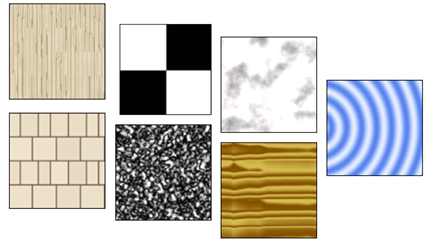Procedural maps add further realism to a material.
Unlike bitmap images, which are produced by a fixed matrix of colored pixels like a mosaic, a procedural map is generated by a mathematical algorithm. Consequently, the types of controls you find for a procedural map vary depending on the capabilities of the procedure. A procedural map can be generated in either two or three dimensions. You can also nest texture or procedural maps within another procedural map to add depth and complexity to the material.

Examples of procedural maps with variations. Top row: Marble, Checker, Speckle and Waves. Bottom row: Tiles, Noise and Wood.
Applies a two-color checkerboard pattern to the material.
Creates ramps using colors, maps, and blends.
Applies a stone color and vein color pattern.
Creates random perturbation of a surface based on the interaction of two colors, texture maps or a combination.
Generates a speckled surface pattern.
Applies a brick or stacked tiling of colors or material mappings.
Simulates water or wave effects.
Creates the color and grain pattern of wood.